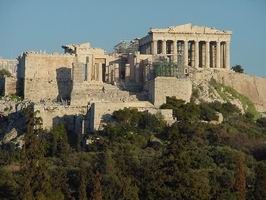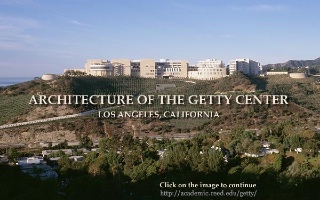Friday - July 02, 2004
 The Athenian Acropolis and the Getty Museum
The Athenian Acropolis and the Getty Museum
I toured the Getty Museum in Los Angeles today and
was struck by how it seemed to reflect the impressions I've always had of the
Acropolis
in Athens. I've never been to Athens, but I've read many descriptions, mostly
Pausanias and others discussing Pausanias. I can't help but think that this is
what the designers intended. Both are located on the top of a hill, with white
stone buildings and lots of open
space.
 But the differences are just as stark
and I think they are more than just arbitrary. They reflect the philosophical
culture of our times and contrast that of the Greeks.
But the differences are just as stark
and I think they are more than just arbitrary. They reflect the philosophical
culture of our times and contrast that of the Greeks.
The Greeks, at least those that made the
Parthenon and much of the Acropolis that it is located on, understood that man
is capable of rational thought and that thinking is what separates men from
animals and allows them to create civilization. In fact they understood that
civilization is possible only with rational thinking. They saw themselves,
rightly, as being able to master their environment. Their architecture reflects
this mindset. The buildings on the Acropolis are made of stone hewn from the
earth and shaped to their desire. They either made statues or walls and
pavement. In the walls of the buildings and monuments, the stones are tightly
fitted and smoothed. They prided themselves on creating columns that are made
of stone so well joined that the joints are virtually invisible. Only more than
2000 years' worth of earthquakes have made some of the joints vaguely
discernible.
This is because the Greeks
knew that they were better than whimsical nature. They were men and they could
think and plan. Entropy is the scientific idea that everything inevitably
trends towards less organization, becoming less organized and more chaotic. The
Greeks possessed intelligence which is the opposite of entropy. They knew that
it was man who created order in the universe and their art celebrated and
reflected this understanding.
Contrast
that with today. Today, like the past 150 years, intellectuals have been
driving our philosophic culture in the opposite direction of the Greeks. Man is
impotent and incapable of understanding nature, let alone improving upon it.
This backwards ideology is reflected in the architecture and often through the
choice of art.
The most striking
difference is in the stones used for the building walls. Unlike the Greeks who
used highly polished, fitted stones, the Getty Museum uses stones with a
purposefully rough surface. Actually, "rough" doesn't quite convey the right
image. These stones are purposefully cut to be as irregular in their outside
face as possible while still maintaining a rectangular cross
section.
So the designer at once wanted
to convey an image of regularity as though it were imposed by the necessity of
the building, yet at the same time project a texture to the wall, presumably to
make it appear more natural. The effect is even more jarring because the
irregular faces of the blocks don't meet at their edges so that if you are near
the wall you are accosted by parts of the smooth sides of the blocks standing
out at the joints. Even worse, there is no mortar and the blocks are spaced
about a quarter inch apart. It's an altogether unpleasing
effect.
There's nothing grotesque about
the stones and how they're used, it's just that the effect isn't very good. It
looks half-made, like they couldn't be bothered to make something that looked
nice. The texture effect isn't bad, and there's something to be said for the
texture versus a highly reflective smooth finish, but the execution fails. I'm
sure it took great skill to make these stones look so badly assembled, it's such
a pity that the skill was purposefully
masked.
And so the Getty Museum's
architecture is a fitting presentation of the mind set of modern art. Modern
artists may, perhaps, almost be skilled, but they work hard to prove that they
aren't.
Go Back to the Start, Do Not Collect $200 Send me your two cents
|
